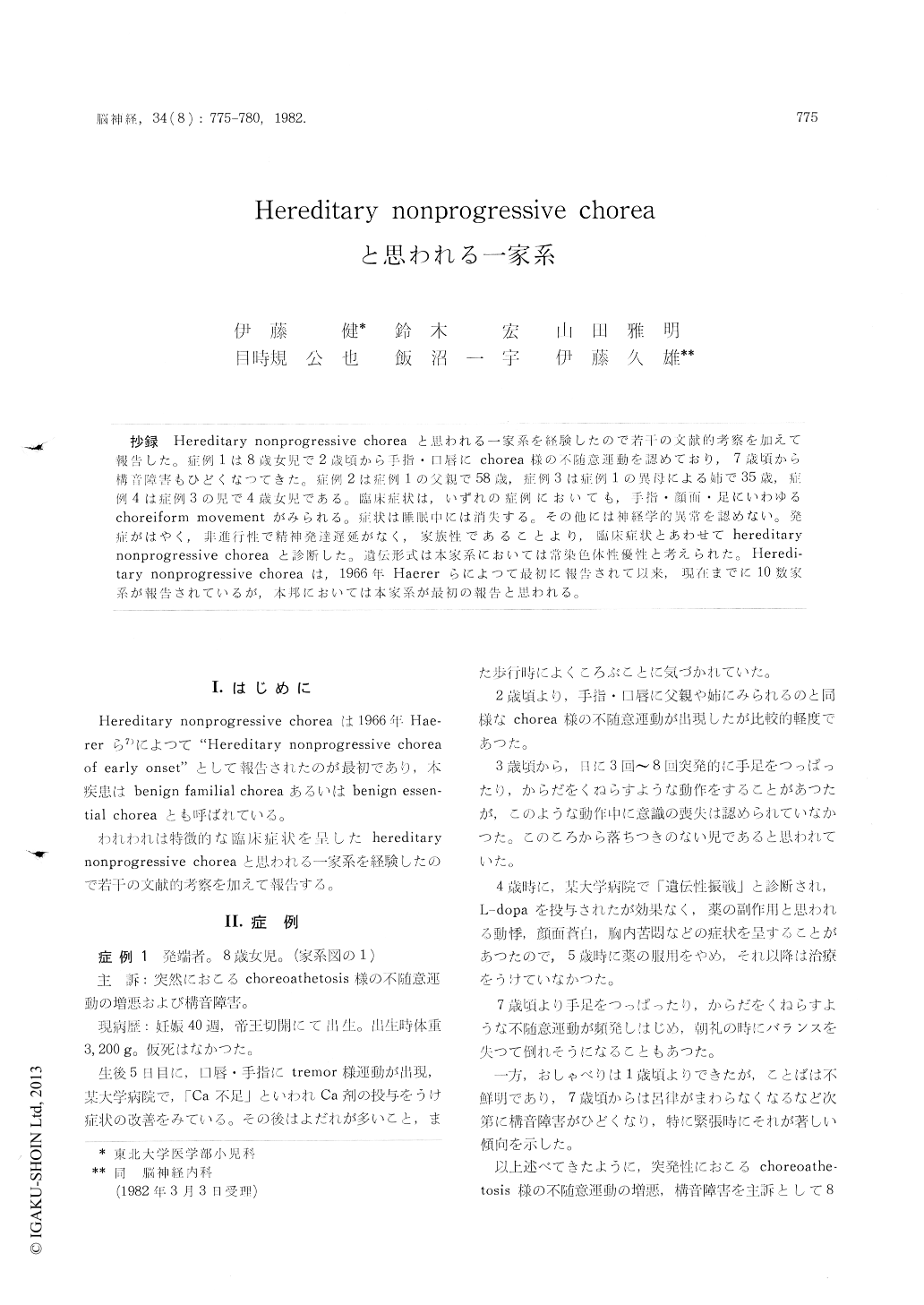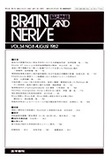Japanese
English
- 有料閲覧
- Abstract 文献概要
- 1ページ目 Look Inside
抄録 Hereditary nonprogressive choreaと思われる一家系を経験したので若干の文献的考察を加えて報告した。症例1は8歳女児で2歳頃から手指・口唇にchorea様の不随意運動を認めており,7歳頃から構音障害もひどくなつてきた。症例2は症例1の父親で58歳,症例3は症例1の異母による姉で35歳,症例4は症例3の児で4歳女児である。臨床症状は,いずれの症例においても,手指・顔面・足にいわゆるchoreiform movementがみられる。症状は睡眠中には消失する。その他には神経学的異常を認めない。発症がはやく,非進行性で精神発達遅延がなく,家族性であることより,臨床症状とあわせてhereditary nonprogressive choreaと診断した。遺伝形式は木家系においては常染色体性優性と考えられた。Heredi—tary nonprogressive choreaは,1966年Haererらによつて最切に報告されて以来,現在までに10数家系が報告されているが,本邦においては本家系が最初の報告と思われる。
Four cases of hereditary nonprogressive chorea in a family were reported. Case 1, an 8-year-old girl was admitted to our hospital because of involuntary movement. She has manifested cho-reiform movement since 2 years of age. At the age of 4 years, she was diagnosed "essential tremor" and administered L-Dopa at a hospital. The medication was stopped, because it did not lessen the symptoms. From the age of 7 years, the paroxysmal choreoathetotic-like movement has developed. The main characteristic symptom was a choreiform movement of fingers, hands, face, lips and tongue which was accentuated by emotional stress and was not seen in sleep. The consciousness was clear and her IQ was 107 by the Tanaka-Binet method. Muscle tone was normal on both extremities. No sensory deficit for tactile, pain, vibration and temperature was observed. Deep tendon reflexes and abdominal reflex were normal bilaterally. Cranial nerves from one to twelve did not show any abnormality. Cerebellar signs such as adiadochokinesia and intention tre-mor were not seen. Her gait was normal and her handwriting seemed to be normal for her age (Fig.1). Laboratory examinations including urinalysis, CBC, ESR, routine liver function tests, BUN, blood sugar, serum ceruloplasmin, copper, uric acid and ASLO titer were all within normal limits.
Case 2, a 58-year-old male farmer, the father of case 1 has shown choreic movement similar to that of case 1 since early childhood. The choreic movement was aggravated by emotional stress and alcohol. The movement was most prominent on hands, fingers and lips. Otherwise, no major neurological abnormality was detected.
Case 3, a 35 year-old house wife. the sister of case 1 has manifested the same, but much less severe choreiform movement than seen in case 1. She did not show other neurological abnormalities.
Case 4 is a 4 year-old girl, daughter of case 3. This patient has occasionally manifested the same choreiform movement as that which case 1 had since 2 years of age.
The pedigree of this family is shown in Fig. 2. According to the pedigree, the mode of here-dity is considered as an autosomal dominant trait with complete penetrance.
More than 10 families of hereditary nonpro-gressive chorea which is also called familial benignchorea and familial essential chorea by other authors have been reported since 1966. However, this specific disorder of involuntary movement has not been reported in Japan.
The major symptom of this disorder is only choreic or choreiform movement without neuro-logic deficits or mental deterioration. However, intention tremor or hypotonia was reported in a few cases. The involuntary movement is aggra-vated by emotional stress and never seen in sleep. The symptom does not essentially change through the life. Interindividual variability of the symp-tom is observed, and intraindividual variability is also observed in some cases. The persistence of the symptom is one of the key points for the diagnosis in addition to the familial occurrence.
The mode of inheritance is variable among the reported cases. An autosomal dominant trait is most common,but an autosomal recessive or an autosomal dominant trait with incomplete pene-trance is shown in some cases. The etiology of this disorder is undetermined. No effective treat-ment has been reported.

Copyright © 1982, Igaku-Shoin Ltd. All rights reserved.


